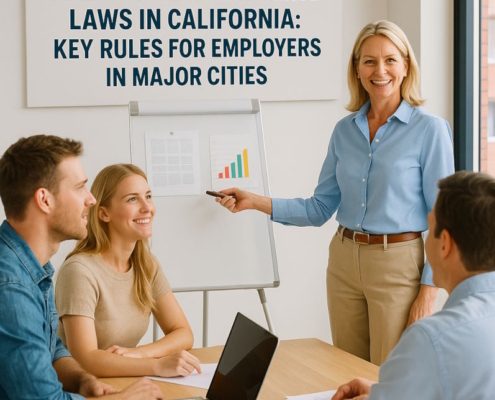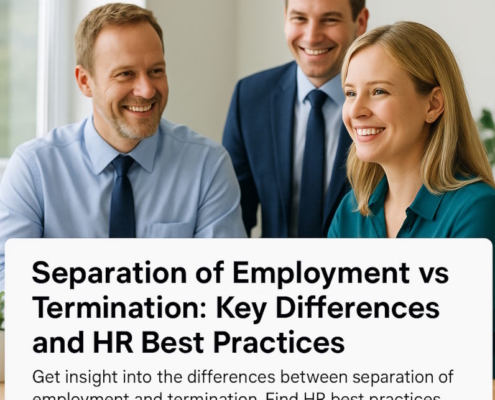Important Takeaways
- Salary-based exempt workers are not entitled to overtime compensation.
- Non-exempt workers are paid on an hourly basis and are eligible for overtime.
- Strict requirements for exempt categorization are set by California labor legislation.
- Employee misclassification may result in financial and legal repercussions.
- During classification, make sure that federal and state labor rules are followed.
Similar to many other states, California’s labor laws distinguish between several employee kinds according to how they work. In California, exempt and nonexempt workers are given different tasks and paid differently. The differences like these can influence how workforce members comply with labor laws regarding breaks, paid time off, and working extra hours.
What are the different ways to know if a position is exempt or not?
Income, title of position, and duties are the primary determinants of whether a job is exempt. Certain legal restrictions are imposed by the state on what qualifies as exempt vs non-exempt California positions.
1. Limits on salaries
A minimum salary is required in California for jobs to qualify as exempt. In California, jobs with annual salaries under $58,240 are typically considered nonexempt. As of the first of January 2021, this amount is equivalent to twice the $14 per hour statewide minimum wage times 52 forty-hour workweeks. The annual cap on non-exempt staff for businesses with 25 or fewer employees is $54,080.
This regulation is not absolute, just like the other standards used to compare exempt vs non-exempt California jobs. As an alternative, it is intended to serve as a guide for California’s state labor commissioners and companies when determining where a given work fits on the measures. An analysis of all the variables influencing the worker’s situation typically yields the ultimate exemption decision.
2. Titles of jobs
Under California law, certain job titles have a higher chance than others of being granted exempt status. Generally speaking, managerial and senior supervisory job titles are more likely to be exempt than lower-rated positions. Executive, managerial, supervisory, and other professional work titles are frequently included in the designated white-collar exemption, albeit there isn’t a comprehensive list of exempt titles of employment.
3. Executive Titles
In the majority of businesses, executives occupy among the most important positions. Although big companies can have hundreds of such individuals, many small and mid-sized businesses have a handful of top-level staff who would be exempt. According to California state law, executive positions are almost always exempt. Executive titles that are frequently used include:
- CEO
- COO
- CFO
- Vice President
- Board Member
- Director
- National/International/Regional Director
4. Administrative titles
Administrative positions differ greatly based on the organization and the job’s specifics. However, California labor law exempts a large number of administrative jobs. Typical titles for exempt administrative positions include:
- Executive Secretary
- Senior Assistant
- Personal Assistant
- Manager/Director/Administrative Assistant/Director/Manager
5. Professional Titles
Professional workers are almost invariably exempt. For labor relations reasons, practically every professional position is seen as being comparable to executive & senior management responsibilities, while there are some outliers. Professional titles for employment include, for example:
- Lawyer
- Consultant
- Doctor
- Senior Accountant
- Web Admin, Database Manager, IT Manager
Professional occupations are typically excluded, but relying just on the job title to determine eligibility isn’t always a good idea. Always consult a labor law expert to see whether a particular position at your business happens to be exempt.
6. Conditions of work
It’s nearly a given that some jobs are exempt. This category includes a number of independent worker classifications, most notably:
- Freelance workers
- Outside sales professionals
- Independent contractors
- Some tech and IT jobs
Generally speaking, jobs that fit under these categories are probably excluded, although there will always be exceptions. It is advisable to consult a labor law expert rather than relying just on a job description or title.
What are the rights of nonexempt & exempt employees?
The obligations and rights for exempt vs non-exempt California jobs differ. The influence of this extends beyond determining the tasks to influencing how the work is classified.
Should a job not be clearly identified or outlined, California labor commissioners may depend on the job’s related perks and other non-listed factors for deciding how to categorize it.
The ultimate decision on classification is unlikely to be influenced by any one aspect. Rather, in order to reach a decision, the labor commissioner often reviews all pertinent information and balances paid time off, benefits, and salaries. Because of this, the framework for paying employees, their pay frequency, and their salary all matter. Additional typical elements include the precise tasks that employees are required to complete on the job and the degree of oversight that their work necessitates.
1. Hourly pay as opposed to salary
One of the primary determinants of an individual’s status as an exempt worker in California is their pay rate. Almost all hourly workers are considered nonexempt, although many salaried workers are exempt. However, this isn’t always true. Not every salaried employee is automatically exempt, and a few exempt workers are paid on an hourly basis.
Depending on how their pay is set up, an employee whose employment would typically be regarded as exempt may in some circumstances end up being regarded as a nonexempt worker.
It may be assumed that a supervisory role is exempt if, for example, the supervisor receives a flat weekly salary of $2,000. However, if a worker takes a half-day leave every second week and their pay is lowered by 10% to compensate for the period of time lost, the position may be considered nonexempt due to the assumption that the pay decrease is related to the number of hours performed rather than the overall amount of work produced.
2. White-collar vs other types of employment
In the US, workers are generally put into categories known as blue-collar & white-collar. Although they aren’t officially defined the same everywhere, blue-collar jobs often require more physical labor than white-collar ones which people handle mostly from offices or at home.
Those with blue-collar jobs include assistants, drivers, and people who operate equipment and machinery. Like numerous office staff whose work is partially physical or somewhat low in a company’s hierarchy, many entry-level workers refer to their positions as “blue-collar.” It can be challenging to make broad generalizations about blue-collar employment due to this variability, but any job that fits this description is probably not exempt in California.
The distinction between blue-collar and white-collar jobs is even hazier. Upper & middle management, legal professionals, university professors, company CEOs, and even customer service and receptionists are examples of white-collar employment. Although it is usually true that exempt individuals typically belong to the white-collar job group, businesses must exercise caution when applying this distinction to determine what employment in California is exempt or nonexempt. Several workers who would be classified as white-collar employees are not excluded, therefore this distinction is only a rough categorization guideline at best.
3. Self-reliance versus supervision
The extent to which a job is exempt under California law also depends on how closely an employee is supervised during their time at work. In California, labor commissioners are able to determine an employee’s level of supervision as part of a labor status determination, however, this one aspect alone is again not decisive.
Compared to exempt workers, nonexempt employees are subject to stricter supervision. As a result, a manufacturing plant’s line workers, who most likely receive close oversight from a foreman and have less direct monitoring from the management, are likely to be regarded as nonexempt, whereas the plant’s executives and managers are likely to be exempt from this need.
However, for some workers, such as beginner truck drivers or those who operate in distant areas with no direct supervision, this isn’t always the case. Despite working at a distance from their closest supervisor, some workers can nonetheless be considered non-exempt. Similarly, even under heavy supervision, a middle management staffer who answers to a senior director in the adjacent office may nonetheless be exempt.
Always seek the advice of knowledgeable legal counsel before assuming that a specific employee’s categorization is impacted by their activities and pay scale, as is the case with potentially complex legal matters. Although the state ultimately decides an employee’s status, management might be guided by knowledgeable employment law specialists in making usually reasonable classification determinations.
How are jobs typically classified?
A comprehensive list of standards for determining whether jobs are or ought to be excluded is not always available to California’s labor commissioners. Despite the existence of guidelines that are a complicated combination of federal and state labor regulations, each commissioner and administrative court judge are allowed to decide every case on its own, within certain bounds.
It’s possible that as an employer, you don’t always know every detail about exempt vs non-exempt California employees. All employers, however, ought to have a rough notion of which positions are likely to fit into which group.
Thankfully, company owners can operate in California without being an authority on employment law. It is customary for many professions to be classified as either nonexempt or exempt. Navigating this area of labor regulation safely might be facilitated by being aware of the general limits.
1. Usually exempt jobs
Certain occupational categories are typically exempt. Although there are always going to be exceptions, several general job categories are usually given the assumption that they are exempt.
Senior management positions are normally considered exempt since they typically have executive titles & employment agreements that outline compensation and working conditions. According to any conventional understanding of labor rules, the worker in question is probably exempt if they are an executive officer, an elected member of the board of directors of the organization, an equity partner, or another extremely senior figure.
There might be an exemption for senior staff members of small businesses, who may nevertheless be subject to terms that might be deemed non-exempt if they performed the same function for a bigger organization despite holding executive or other high job designations.
Another workforce that is almost frequently excluded from overtime compensation and breaks is contractors. Apart from not being official employees of the business that they work for, contract workers are often compensated based on their production instead of their hours worked. These factors frequently lead to the classification of certain IT personnel, business lawyers, chartered accountants, and marketing positions as exempt.
However, California’s labor commissioners frequently acknowledge that these rules don’t always apply. An individual who lacks a professional qualification or a formal contractor’s license may be deemed non-exempt. This is more likely to happen if the contract worker is paid on an hourly basis, is closely supervised, and has no clients outside of one organization.
2. Positions that are often not exempt
In many respects, a nonexempt position is simpler to identify than its exempt equivalent. Entry-level workers are usually presumed to be nonexempt unless there is proof to the contrary. The possibility is that a job is not free from labor laws if it is low in rank or authority, pays on an hourly basis, is closely supervised, and is considered an at-will position.
It would be too lengthy to describe all of California’s nonexempt jobs, but when in confusion, it’s probably preferable to presume a position falls under this group rather than risk misclassifying a worker as exempt.
Custodial, customer service, transportation, and entry-level food service positions are a few examples of common nonexempt jobs. Generally speaking, those who are employed to lift heavy items, clean dishes or surfaces, stock shelves, or do laundry are nearly never exempt.
For the most part, many medical occupations—such as entry-level nurse and paramedic positions—are also not exempt, while emergency personnel and other healthcare professionals may be excused from the regulation regarding breaks, depending on their line of work.
3. Jobs that are open-ended
Certain jobs are inherently on the verge of becoming exempt or nonexempt. Some occupations may be partially autonomous, like salespeople who only receive commissions and bonuses, or they can be middle management roles, like a shift manager at a franchise or line manager for a small kitchen.
Additionally, assistants blend the boundaries of exempt vs non-exempt California classification. For the most part, executive assistants and private assistants may be considered exempt, but the average administrative worker or receptionist is likely to be classified as a nonexempt worker. Law clerks, legal secretaries, assistants, and other paraprofessionals have a variety of jobs and may be governed by state regulations.
Another example of an edge case between categories may be real estate agents and realtors. The agents’ compensation, whether they must work a certain amount of hours, and their degree of discretion regarding dress code, personal vehicle use, and client contact standards may be the deciding factors in this situation.
The area of uncertainty for employment law exemptions also includes beauticians, barbers, and hairdressers. Technically, some beauty practitioners in California are freelancers who rent premises at a salon to work independently, but many are completely nonexempt workers for salons and beauticians’ businesses.
In this case, it is a good idea to consider the worker’s compensation. A hairdresser is most likely considered a nonexempt employee if they get an hourly salary from the business that runs the salon. An exempt contractor may be one that pays franchise fees or rent is able to leave and return on their own time, and uses their own materials.
Since there are so many edge circumstances, it is impossible to compile a precise list of occupations that fit into each group, and many jobs require special treatment entirely. Ask a lawyer with knowledge of California labor laws if you’re ever unsure about the possible status of a job at your company, and do your best to abide by their written advice.
What happens when a job is incorrectly classified?
Employers in California have a strong incentive to classify their workers appropriately. The state may assume that businesses that make what might have been a genuine mistake could be found to have engaged in misconduct and are subject to sanctions since there may be a financial motive to classify nonexempt personnel as exempt. Prepare for the possible repercussions of incorrect categorization.
Apart from the state’s legal penalties, firms who misclassify workers risk being sued for overtime wages and back pay. A lot of workers who won cases like this might also receive rewards for additional infractions, such as unpaid time off.
FAQs
1. Does California require exempt workers to allow themselves a lunch break?
Some exempt employees are entitled to meals and rest periods, but not all of them are. For example, truck drivers and sales representatives are entitled to paid breaks, while executives are not. To find out more about the meal & rest break regulations for each position, speak with a labor lawyer.
2. Can you mandate that exempt workers take partial days off using paid time off?
While California employers may mandate the use of vacation or sick leave, they are not allowed to deduct absenteeism or partial time off from the regular salaries of exempt employees. If an exempt employee’s vacation time is insufficient to compensate for an absence, they will either have to receive their usual income or risk losing their exemption.































